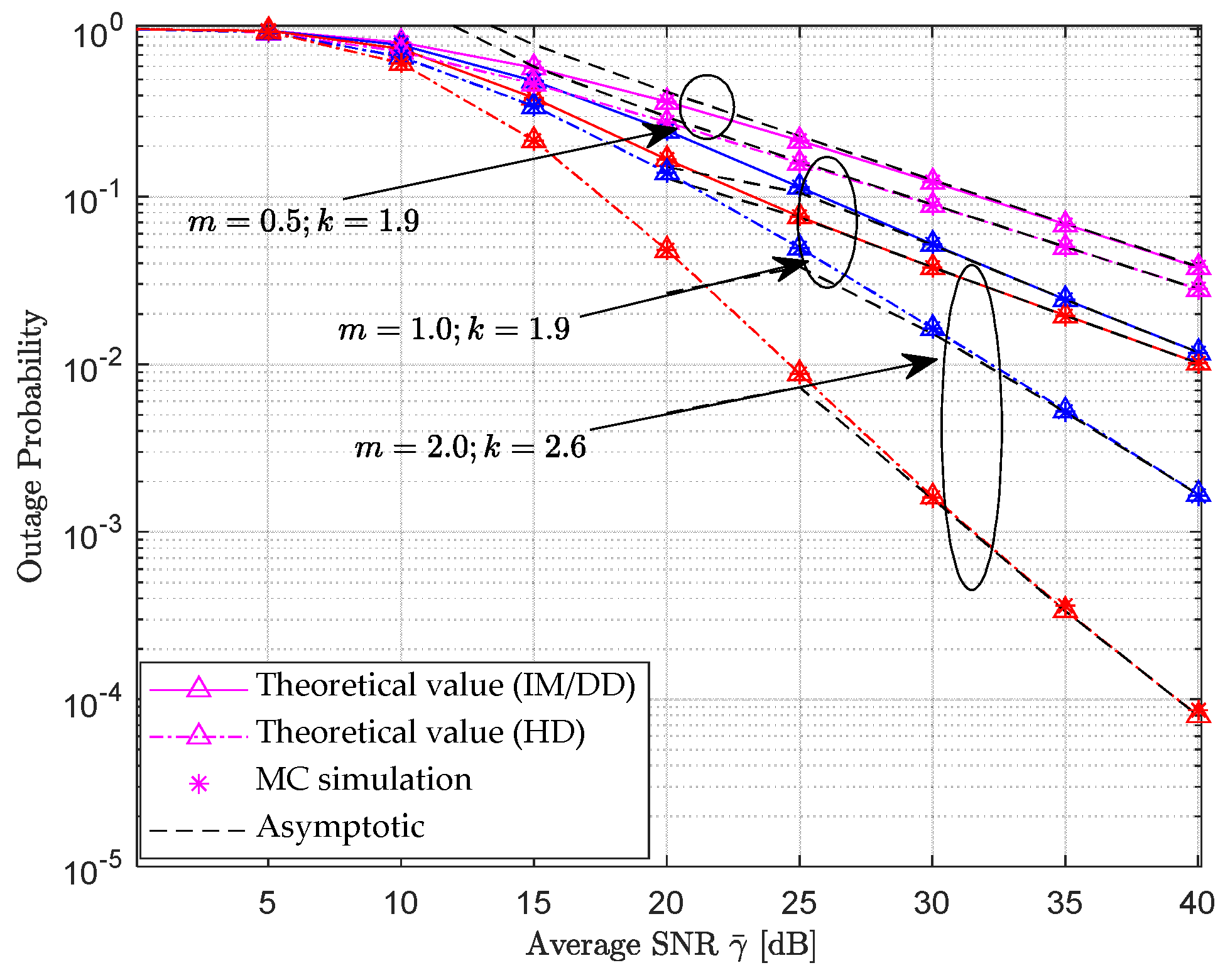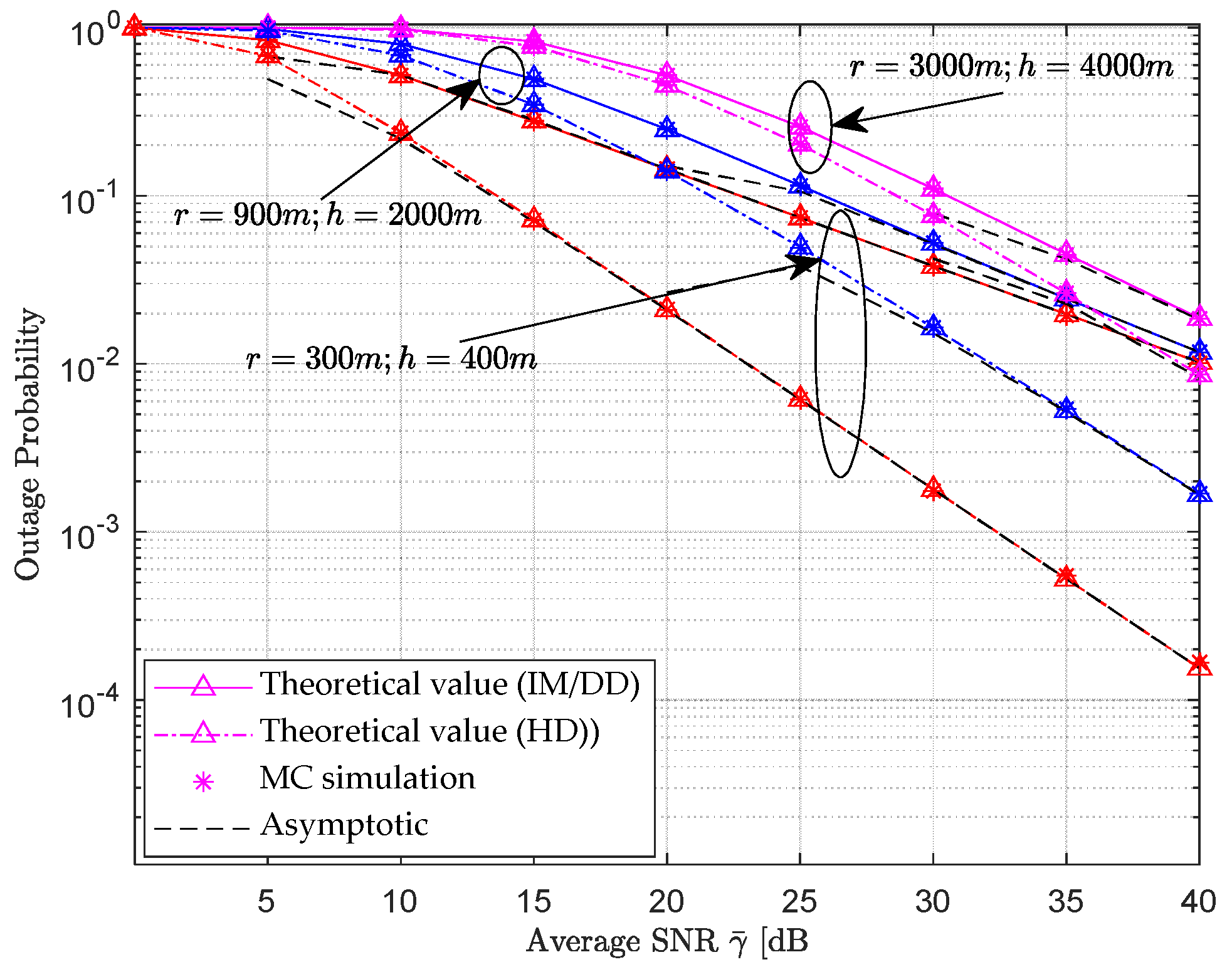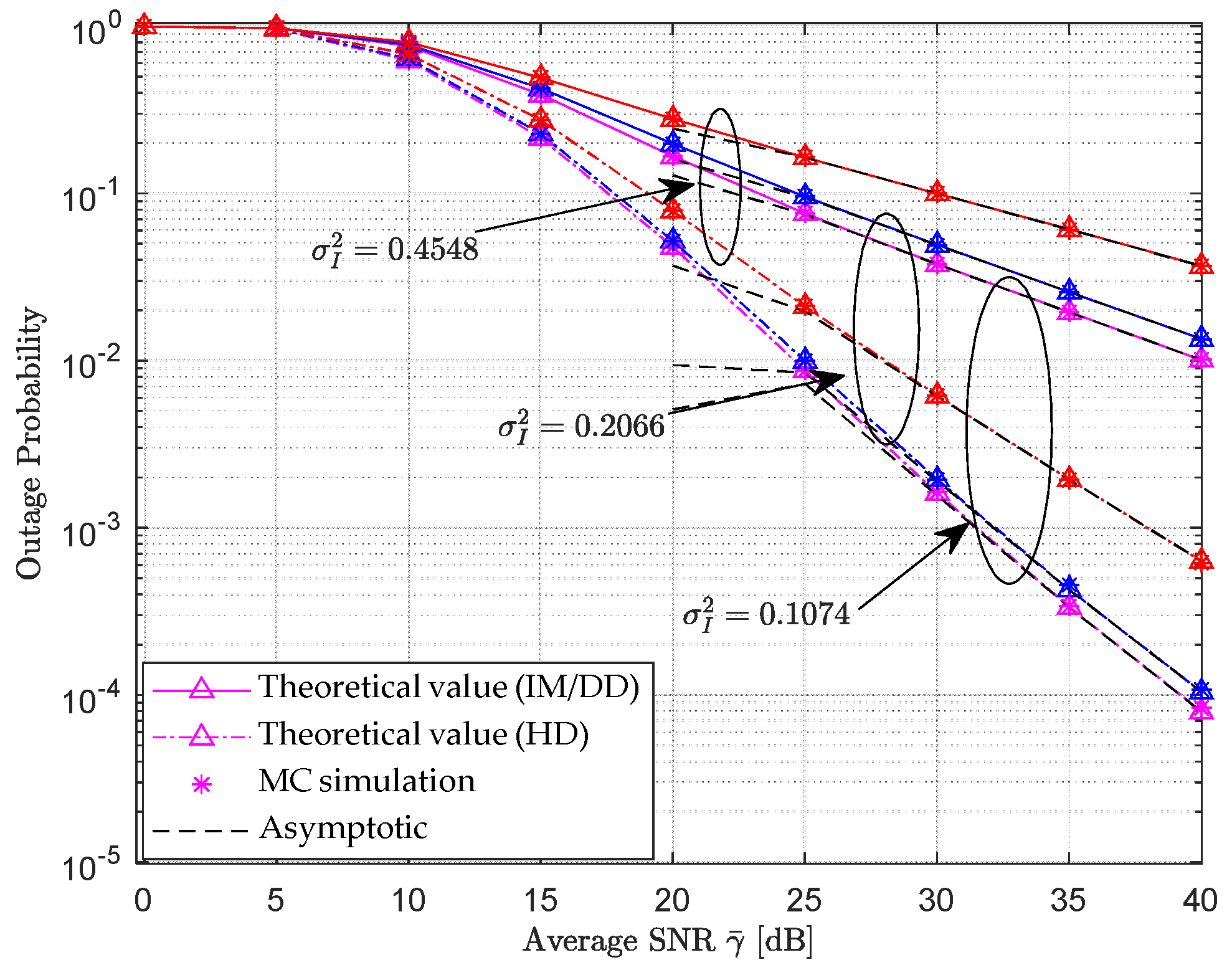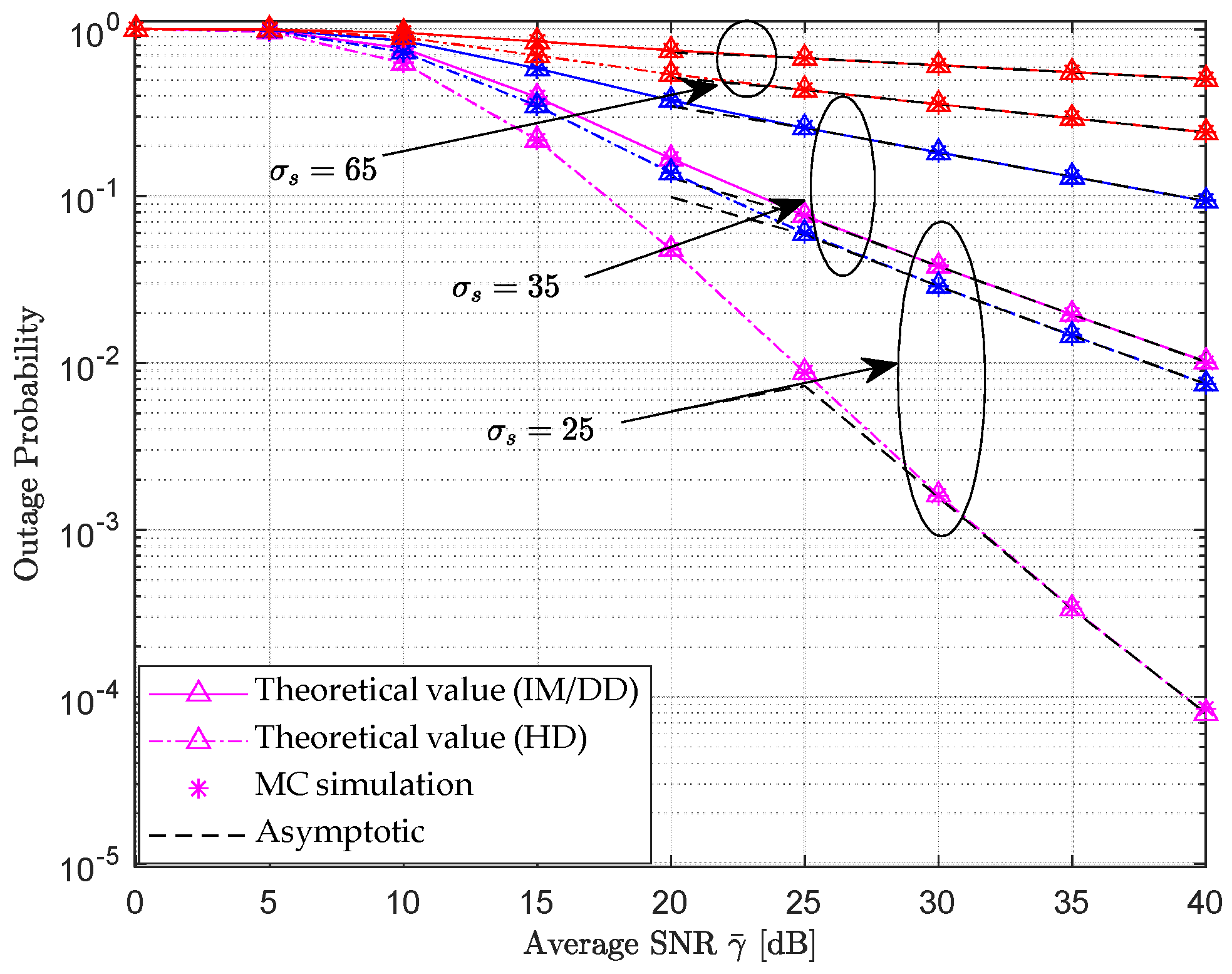1. Introduction
Underwater Wireless Optical Communication (UWOC) has received extensive attention from a large number of scientific researchers due to its many advantages such as high signal bandwidth, low transmission delay, strong confidentiality, and exemption from spectrum authorization [
1]. In recent years, to meet the practical need of realizing the mutual transmission of observation information between airborne/space/ground nodes on land and underwater targets over long distances, cross-media hybrid relay transmission architectures of Radio-Frequency (RF)-UWOC [
2] or Free Space Optical (FSO)-UWOC have emerged [
3].
Reference [
3] proposed a multi-hop Free Space Optical (FSO) and Underwater Wireless Optical Communication (UWOC) relay communication system that can be used for the tracking of Autonomous Underwater Vehicles (AUVs). In a fading environment, the expressions of the system’s end-to-end average bit error rate (BER) and outage probability were analyzed and derived. For the FSO link, the influences of Gamma–Gamma (GG) turbulence fading and pointing error were considered, while for the UWOC link, the Lognormal distribution was adopted to model the effect of ocean turbulence. Both links used the Beer–Lambert exponential law to model the atmospheric and oceanic path losses.
Reference [
4] studied the outage probability, bit error rate, and channel capacity of a hybrid two-hop communication system composed of FSO-UWOC links under the Amplify-and-Forward (AF) mechanism. Among them, the GG atmospheric turbulence model was used for the FSO link, and the Exponential-Generalized Gamma distribution was used to model the underwater turbulence channel for the UWOC link. The impacts of atmospheric and underwater path losses on the system performance were not considered.
Reference [
5] studied the outage probability and bit error rate of a two-hop communication system composed of FSO-UWOC hybrid links under the assistance mechanism of Reconfigurable Intelligent Surface (RIS). For the FSO link, the GG atmospheric turbulence fading and pointing error were considered. For the UWOC link, only the Lognormal distribution was selected to simulate the ocean turbulence without considering the influence of pointing error. Also, the path loss factors were not considered for both links. It is obvious that all the above-mentioned studies modeled and analyzed the communication links between airborne/ground and sea surface relay nodes using FSO.
However, in terms of RF-UWOC, which is the focus of this paper’s research, Reference [
6] analyzed the outage probability, bit error rate, and ergodic capacity of a RIS-assisted RF-UWOC hybrid two-hop system. Among them, the RF link was modeled as Nakagami-m and Rayleigh small-scale fading, and the UWOC link was modeled as EGG turbulence fading. The path losses encountered by the two links and the adverse effects of the pointing error on the UWOC link were not considered.
Reference [
7] derived the outage probability and bit error rate of a UAV-based RF-UWOC hybrid two-hop system in a fading environment and accordingly analyzed and solved the hovering height of the UAV that minimizes the system outage probability. Among them, the RF link was modeled as a hybrid model of Nakagami-m small-scale fading and atmospheric path loss, and the UWOC was modeled as only having EGG turbulence fading. Similarly, the effects of the pointing error and underwater path loss were not considered.
Reference [
8] studied the outage probability and ergodic capacity of a hybrid two-hop RF-UWOC system when using power-domain non-orthogonal multiple access technology to address two different underwater users and modeled and solved the optimal power allocation strategy for underwater users with the optimization goal of minimizing the system outage probability. Among them, the RF link was modeled as a small-scale Rayleigh fading channel, and the UWOC only considered the influence of the EGG turbulence fading factor.
Reference [
9] proposed an uplink fusion system of multi-hop UWOC and RF assisted by RIS carried by an AUV. Under the conditions of considering ocean turbulence and pointing error, the outage probability and average bit error rate of the system were analyzed. Among them, the UWOC link was modeled as underwater path loss described by the Beer–Lambert law, pointing error, and EGG turbulence effect; the RF link used the complex Fisher–Snedecor F distribution to model the influence of small-scale fading and shadowing effects, and the effect of path loss was not considered. In addition, this paper also did not consider the comparison of the system performance of the UWOC link under different receiving and detection schemes such as heterodyne detection (HD) and intensity modulation with direct detection (IM/DD).
Synthesizing the above research status of the cross-media FSO/RF-UWOC hybrid two-hop relay system, it can be seen that due to the different communication mechanisms, the channel modeling of the FSO and RF links above the water surface is not comparable. However, just in terms of the operation of the RF link, generally only the influence of small-scale fading is considered while the effects of large-scale shadowing or path loss are ignored. Obviously, the channel modeling of the RF link is far from perfect. On the other hand, for the UWOC link, the Lognormal distribution model directly transplanted from the atmospheric FSO environment or the EGG distribution model, which is not transplanted but relatively complex, is generally used to model the ocean turbulence fading. At the same time, the two unfavorable factors of pointing error and underwater path loss are often ignored. Or, although the influence of path loss is considered, the adopted path loss model is the unreasonable single-exponential Beer–Lambert model [
10]. That is to say, there are imperfections or irrationalities in the existing channel modeling of the RF-UWOC system, and it is necessary to conduct special research on the performance of this hybrid two-hop system under a novel and complete channel model.
Based on the above background, this paper proposes to model the composite channel fading of the RF link using the Generalized K distribution and atmospheric path loss. Among them, the Generalized K distribution includes Nakagami-m small-scale fading and Lognormal shadowing effects, so that this composite model can comprehensively reflect the complete effects of small-scale fading, large-scale fading, and path loss. The UWOC link is modeled as a novel composite channel fading of the Simple Generalized Gamma Distribution (GGD), zero line-of-sight pointing error(negligible jitter), and Elamassie underwater path loss. Among them, the GGD model, through experimental testing, is an effective model that is simpler in mathematical expression than the EGG model but can perfectly describe the weak–medium–strong, three kinds of turbulence effects [
11]. The Elamassie path loss model is also a path loss model that can more accurately describe the path loss including the effects of seawater absorption and scattering, as well as geometric loss than the traditional single-exponential Beer–Lambert law, which has been verified by simulation experiments [
10]. Many studies only consider turbulence using the EGG model, but it is too complex and unreasonable, either only considering the pointing error or not considering the path loss, or incomplete consideration. In the system HD (coherent detection), modulation mode (BPSK) was used with devices to realize the underwater complexity less than IM/DD or the OOK complex, but its system performance from the principle is achievable, so the focus of this thesis is to consider the performance of the probability of interruption, and not consider the complexity of its implementation.
Based on this novel and complete composite fading channel model of the two links, the theoretical closed-form expression of the average outage probability of the RF-UWOC hybrid two-hop relay transmission system using the Decode-and-Forward (DF) mechanism and its asymptotic expression under high signal-to-noise ratio are derived. The performance differences in the receiver under different detection schemes of IM/DD and HD are systematically compared and analyzed. Finally, the Monte Carlo numerical simulation is used to verify the correctness of the above theoretical derivation results and to investigate the influence of different core parameters on the system performance. The major contributions of this study are summarized as follows:
- (1)
Propose a novel composite channel fading environment that models an RF link experiencing Generalized K distribution and atmospheric path loss fading under the “decode-and-forward” mechanism, while the UWOC system undergoes GGD ocean turbulence, zero-axis pointing error loss, and Elamassie underwater path loss.
- (2)
This paper analyzes the performance of a novel and complete double-link composite fading channel model. First, using advanced transcendental Meijer-G functions and Fox-H functions, we derive detailed theoretical closed-form expressions for the average outage probability of a RF-UWOC hybrid two-hop relay transmission system using the Decode-and-Forward (DF) mechanism. We also provide asymptotic expressions under high signal-to-noise ratios and systematically compare the performance differences in the receiver using different detection schemes of IM/DD and HD. Subsequently, we validate the correctness of the above theoretical derivations through Monte Carlo numerical simulations and examine the impact of key parameters such as oceanic fading index and jitter deviation on system performance.
Table 1 summarizes key differences between the proposed model and related works.
4. Simulation Results and Analysis
This section uses Monte Carlo (MC) simulation to verify the accuracy of the theoretical analysis results and examines the impact of core parameter selection on system performance. Assuming that the UWOC link operates in the water quality of the nearshore coast, its extinction coefficient satisfies the require
. The typical values of other important parameters required for system simulation are shown in
Table 2 Further assuming that the average signal-to-noise ratio of the two-hop links is equal, that is,
, the threshold noise is set
.
Figure 2 shows the theoretical calculation values and MC simulation values of the average outage probability of the RF-UWOC hybrid double hop relay transmission system under different RF link parameter values as a function of the average SNR
. The solid line in the figure represents IM/DD detection, while the dotted line represents heterodyne detection (HD), the dashed line represents the corresponding asymptotic value curve, and the asterisk represents the MC simulation value. At this point, the coefficient values for the Generalized K distribution channel fading of the first hop RF link are set as follows
:
[
21] (Correspond to the pink, blue, and red curves in the figure respectively). where the horizontal and vertical distances between UAV and R:
, and the weak pointing error
of the second hop UWOC link (corresponding to jitter deviation
, receiver radius
, and beam width
); underwater transmission distance
; ocean turbulence scintillation index
. From the simulation results in
Figure 2, it can be seen that under the condition of fixed parameters of the UWOC link (underwater transmission distance
, ocean turbulence intensity
, and pointing error
), whether the system adopts IM/DD detection or heterodyne detection receiving schemes, the performance of outage probability will continue to improve due to the increase in coefficient values in the RF link. This is due to the value of m that reflects the intensity of small-scale Nakagami fading in the RF link, and the smaller the value of m, the closer the small-scale fading is to the weak. Rician fading of the direct path signal. The
value is inversely proportional to the average power of the random variable that characterizes large-scale shadow fading, and the larger the
value, the weaker the shadow effect. All of these indicate that generalized K-fading has a significant impact on the outage probability performance in RF links. In terms of receiving detection schemes, as heterodyne detection belongs to coherent detection, and under the same system average signal-to-noise ratio
conditions, heterodyne detection will obtain lower system outage probability values than incoherent IM/DD detection because coherent detection mechanism can effectively suppress noise and fading effects by utilizing the phase and frequency information of the signal, particularly showing stronger performance in composite fading channels (such as strong turbulence and large pointing errors).
In addition, the theoretical calculation values of the system are in good agreement with the MC simulation values, and the asymptotic value of the outage probability at high SNR also basically coincides with the theoretical value at the corresponding signal-to-noise ratio. This indicates the correctness of the closed form formula derivation results related to the theoretical and asymptotic values of the system outage probability mentioned above.
Figure 3 shows the theoretical and MC simulation values of the outage probability of the hybrid dual-hop RF-UWOC relay communication system under different UAV hovering heights and horizontal distances, as a function of the average SNR
. Similarly, the solid line in the figure represents IM/DD detection, the dotted line represents heterodyne detection, the dashed line represents asymptotic value curve, and the asterisk represents MC simulation value. Set the horizontal and vertical distances between UAV and R in the RF link as follows
:
(Correspond to the red, blue, and pink curves in the figure respectively.) corresponding to the linear distance
between UAV and R (generalized K-fading coefficient:
), pointing error
of the second hop UWOC link, underwater transmission distance
, and turbulence scintillation index
. From the simulation results in
Figure 3, it can be seen that under the condition of fixed UWOC link simulation parameters, the outage probability of the hybrid double hop system will show a downward trend in performance due to the increase in the hovering height of the UAV as a floating base station in the RF link and the horizontal distance from the relay node R. This is mainly due to the increase in the straight-line distance
from UAV to R, which leads to an increase in road loss
. However, under the same road loss conditions, outage probability still decreases with the increase in the average signal-to-noise ratio, indicating that increasing the received signal-to-noise ratio is still beneficial for improving system performance. Similarly, in terms of receiving detection schemes, as heterodyne detection belongs to coherent detection, under the same system average signal-to-noise ratio conditions, heterodyne detection will obtain lower system outage probability values than incoherent IM/DD detection.
Figure 4 shows the theoretical outage probability and MC simulation values of a hybrid dual-hop RF-UWOC relay communication system under different intensities of ocean turbulence (turbulence scintillation index
= 0.1074/0.2066/0.4548, Correspond to the pink, blue, and red curves in the figure respectively) experienced by the second hop UWOC link with fixed channel parameters of the first hop RF link, as a function of the average signal-to-noise ratio. At this point, the horizontal and vertical distances between UAV and R in the first hop RF link are set as follows
:
; the coefficient values that obey generalized K-fading are
, weak pointing error
of the second hop UWOC link; underwater transmission distance
. From the simulation results in
Figure 4, it can be seen that when the scintillation index, which characterizes the intensity of ocean turbulence, initially increases, the system performance does not deteriorate significantly. For example,
, and when the scintillation index increases, the corresponding two performance curves are basically close, while when
, the performance gap between the scintillation index and the scintillation index increases, and the performance decreases significantly. The reason for this is that the asymptote formula for system outage probability represented by Equation (29) shows that its asymptote is related to
several system attenuation parameters that characterize the intensity of small-scale Nakagami fading in RF links, large-scale shadow fading parameters, ocean turbulence intensity, and UWOC link pointing error. When setting the ocean turbulence scintillation index
, it can be observed that compared to other parameter values
,
, the asymptotic value of the system average bit error rate in high SNR areas is basically determined by the fading parameter
of the RF link, which is independent of the intensity of ocean turbulence. When the intensity of ocean turbulence increases
, it is
less than the values
of the other three parameters, so the asymptotic value of this curve will be determined by the ocean turbulence coefficient
. Obviously, the performance of the outage probability curve corresponding to ocean turbulence
will be even worse than the performance
of these two curves. Under the same conditions of ocean turbulence, the probability of system outage decreases with the increase in the average signal-to-noise ratio, and there is also performance improvement with the introduction of coherent HD. All of these indicate that increasing the received signal-to-noise ratio and using coherent reception are beneficial for improving system performance.
Figure 5 shows the theoretical outage probability and MC simulation values of the hybrid dual-hop RF-UWOC relay communication system as a function of the average signal-to-noise ratio when the channel parameters of the first hop RF link are fixed but the jitter dispersion
of the second hop UWOC link is changed, Correspond to the pink, blue, and red curves in the figure respectively. At this point, the horizontal and vertical distances between UAV and R in the first hop RF link are set to:
, and the coefficients that follow generalized K-fading are set to:
. The pointing error
of the second hop UWOC link varies with jitter deviation (at this point, the receiver radius
and beam width
); underwater transmission distance
, ocean turbulence scintillation index
. From the simulation results in
Figure 5, it can be seen that as the jitter deviation
value representing pointing error gradually increases, the overall curve of the system outage probability changing with the average signal-to-noise ratio gradually rises, that is, the outage probability performance shows a downward trend. The reason for this is that the value represents the amplitude of random jitter between the received light intensity at the receiver and the center of the receiving aperture. Obviously, the larger the jitter amplitude, that is, the larger the value, the less signal energy will fall into the receiving aperture, the lower the received signal-to-noise ratio (SNR), and the probability of outage will inevitably decrease. However, the simulation results in
Figure 5 also reveal that increasing the average signal-to-noise ratio and changing the detection method can effectively improve the outage probability performance of the system under the same system parameter conditions.
Figure 6 shows the theoretical outage probability and MC simulation values of a hybrid dual-hop RF-UWOC relay communication system with fixed channel parameters for the first hop RF link but varying transmission distance
(Correspond to the pink, blue, and red curves in the figure respectively.) for the second hop UWOC link, as a function of the average signal-to-noise ratio. At this point, the horizontal and vertical distances between UAV and R in the first hop RF link are set to
; the coefficients that follow generalized K-fading are set to
, the strong pointing error
(receiver radius
, beam width
) of the second hop UWOC link, and the ocean turbulence scintillation index
. From the simulation results in
Figure 6, it can be seen that as the underwater transmission distance decreases, the outage probability performance of the corresponding hybrid double hop system improves. This is due to the significant attenuation of the Elamassie underwater path loss represented by Equation (10) after the transmission path is reduced. Similarly to the simulation results of other figures, under the same system parameter settings, the HD scheme belonging to coherent detection is significantly more effective than the IM/DD scheme belonging to non-correlated detection. Moreover, both the MC simulation values and asymptotes can perfectly match the theoretical values, indicating that the derivation of the outage probability theory formula and asymptote formula mentioned above is correct and reasonable.












